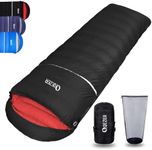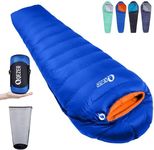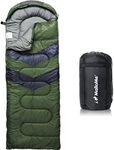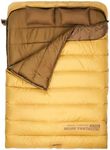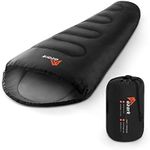Buying Guide for the Best Winter Sleeping Bag
Choosing the right winter sleeping bag is crucial for ensuring a warm and comfortable night's sleep in cold conditions. The key is to find a sleeping bag that matches the temperatures you expect to encounter, while also considering factors like weight, size, and material. Understanding the specifications of a sleeping bag will help you make an informed decision that suits your specific needs and preferences.Temperature RatingThe temperature rating of a sleeping bag indicates the lowest temperature at which the bag will keep the average sleeper warm. This is important because it helps you choose a bag that will keep you comfortable in the conditions you expect to face. Temperature ratings are often divided into three categories: summer, three-season, and winter. For winter camping, look for a bag with a temperature rating of 0°F (-18°C) or lower. Consider your personal comfort level and whether you tend to sleep warm or cold when selecting a temperature rating.
Insulation TypeInsulation in a sleeping bag is what keeps you warm by trapping heat. There are two main types: down and synthetic. Down insulation is lightweight, compressible, and offers excellent warmth-to-weight ratio, making it ideal for cold, dry conditions. Synthetic insulation is bulkier but performs better in wet conditions and is generally more affordable. If you expect wet conditions or are on a tighter budget, synthetic might be the way to go. For dry, extremely cold environments, down is often preferred.
ShapeThe shape of a sleeping bag affects its warmth and comfort. The most common shapes are mummy, rectangular, and semi-rectangular. Mummy bags are snug and efficient at retaining heat, making them ideal for cold weather. Rectangular bags offer more room to move but are less efficient at heat retention. Semi-rectangular bags offer a compromise between warmth and space. If you prioritize warmth and weight, a mummy bag is best. If comfort and space are more important, consider a rectangular or semi-rectangular shape.
WeightThe weight of a sleeping bag is crucial if you plan to carry it on your back for long distances. Lighter bags are easier to carry but may sacrifice some warmth or durability. Winter sleeping bags tend to be heavier due to additional insulation. If you're backpacking, aim for a balance between weight and warmth. If you're car camping, weight may be less of a concern, allowing you to opt for a heavier, more insulated bag.
Size and FitThe size and fit of a sleeping bag affect both comfort and warmth. A bag that is too large can leave cold spots, while one that is too small can be uncomfortable. Sleeping bags come in different lengths and widths, often with options for regular, long, and sometimes extra-wide. Choose a size that allows you to move comfortably but is snug enough to retain heat. Consider your height and body shape when selecting the right size.
Shell and Lining MaterialThe shell and lining materials of a sleeping bag contribute to its durability, comfort, and water resistance. Shells are typically made from nylon or polyester, often with a water-resistant coating to protect against moisture. Linings are usually softer materials for comfort. If you expect damp conditions, look for a bag with a water-resistant shell. For comfort, ensure the lining feels good against your skin. Durability is also important if you plan to use the bag frequently or in rugged conditions.

